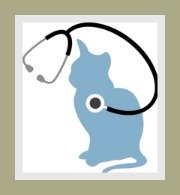Feline Diarrhea
Causes of Runny Tummies in Cats
Feline diarrhea is a symptom of various cat illnesses.
Diarrhea is described as the frequent passing of watery stools (feces).
Apart from the frequency of bowel movements and loose stools, veterinarians believe that a cat that produces frequent increased volumes of feces also has diarrhea.
Any feline disease that decreases the ability of your cat's bowel to absorb fluid or stimulates your cat's bowel movement will result in your cat having diarrhea.
Cat health problems like diarrhea can be caused by serious systemic diseases to something as simple as a change in diet.
The causes are many and varied. If your kitten or cat has diarrhea it should be taken to a vet for a full examination and diagnosis.
causes of cat diarrhea
1. diet
Changing the cat's diet or introducing new unfamiliar foods which are difficult to digest.
A diet rich in fibre will result in increased fecal bulk and diarrhea
Food intolerance (food allergy) is by far the most common reason why cats get diarrhea.
An example of food intolerance is lactose intolerance due to ingestion of cow's milk.
Feral cats and outdoor cats who are allowed to roam may scavenge and ingest food that is 'off' resulting in cat stomach problems.
Over-eating in young kittens may result in cat diarrhea
2. stress diarrhea
Moving home, boarding your cat, a new addition to the family - any change to a cat's environment may result in stress diarrhea.
3. poisons or toxins
The accidental or deliberate ingestion of toxic plants, pesticides, herbicides or household chemicals may cause diarrhea and vomiting.
4. viral infections
There are a number of viral cat diseases that also present with feline diarrhea. Read more at feline diseases.
5. bacterial infections
Feline diarrhea can be caused by a number of bacteria:
Escherichia coli (E.Coli) bacteria can cause Colibacillosis which generally affects young kittens especially those who have not received antibodies from their mother due to early weaning.
Kittens can be infected by a nursing queen infected with E.Coli.
Salmonella bacteria is food borne and is contracted by cats when feeding off contaminated food or infected prey which they catch.
Salmonella is also transferable to humans (i.e. zoonotic).
Clostridium perfringens bacterium, whilst rare, may cause Clostridial enterotoxicosis in cats.
Cats become contaminated by eating raw or under-cooked meat.
Young kittens who have not received antibodies from their mothers are also at risk of becoming infected with this bacterium.
6. intestinal parasites
Hookworms, Tapeworms and Roundworms are the most common internal parasites that cause feline diarrhea.
Giardia is a protozoan intestinal parasite.
Cats usually ingest the cysts via contaminated water, food or during self-grooming.
Giardiasis affects the small intestine and the resultant diarrhea does not contain blood. It is not believed to transfer to humans.

Tritrichomonas foetus is a flagellated protozoan parasite which causes inflammation of the large bowel i.e. colitis resulting in liquid feces which may contain blood and mucus.
It is not known whether Tritrichomonas foetus can affect humans, so care should be exercised when handling cats with feline diarrhea.
Cryptosporidium is a protozoan parasite.
Cats become infected by ingesting sporulated oocysts from water, food or an environment contaminated with fecal matter.
Cryptosporidium affects the cat's small intestine. Immuno-compromised humans can become infected with this parasite.
Coccidium is a protozoan intestinal parasite that is acquired via ingesting sporulated oocysts from a contaminated environment.
It is a fairly common parasite and causes feline diarrhea which may contain mucus or blood. It is not believed to transfer to humans.
7. inflammatory bowel disease (IBD)
IBD is an obscure inflammatory disease that affects different parts of the gastrointestinal tract.
The most common one in cats is lymphocytic-plasmacytic enteritis which affects the small intestine.
Inflammation of the large intestine is known as Eosinophilic Enterocolitis.
IBD largely affects older cats, but the cause is unknown.
It could be a reaction or hypersensitivity to antigens, genetic or a problem of the immune system.
8. straining at defecation
A blockage or inflammation of the mucosa (lining) of the rectum will make it painful and difficult for the cat to pass feces.
This constant straining results in the cat passing watery stools.
Blockages can be from hairball, tumors or other foreign bodies.
If the anal sacs (scent glands) become inflamed this will also result in straining and feline diarrhea.
9. tumors and cancer
Lympho-sarcoma or lymphoma is cancer of the lymphatic system.
When it involves the gastrointestinal tract it causes a thickening and destruction of the intestinal walls.
In this instance feline diarrhea will present as a dark, tarry stool due to the presence of blood.
10. hyperthyroidism
Hyperthyroidism is defined as an over-active thyroid gland.
This cat disease is found in older cats and is characterized by a number of symptoms including an increased amount of feces that is quite greasy in appearance.
11. systemic disease
Diseases of the kidneys, liver and pancreas present with a wide range of symptoms including feline diarrhea.
diarrhea vs normal feces
It is important as a cat owner, that you are able to identify the difference between a cat with normal bowel movements and a cat with diarrhea.
You should take note of:
- the frequency that your kitty passes stools
- the amount
- color and
consistency of stool
If you are 'familiar' with your cat's feces your are more likely to detect any changes and hence more likely to seek early treatment for feline diarrhea.
Generally, a healthy cat will have 1 - 2 bowel movements a day.
Cat feces is not as well formed as dog feces and their feces is of a softer consistency, but a putty-like texture is considered normal.
The color of the feces will be determined by your cat's diet:
- if your cat is fed on
fish and chicken it will have a pale stool;
- if fed on red meat or a raw
diet your cat will have a darker stool;
- if your kitty is fed commercial dry cat foods it may have a stool which is dark with a reddish tinge.
feline diarrhea is serious
If diarrhea is persistent and left untreated it can cause dehydration and death.
Your cat or kitten may have a serious viral disease which is life-threatening.
Your kitten may develop intussusception which is a condition where one portion of the intestine slides into the next (much like closing a telescope).
This causes an obstruction of the bowel and can be fatal if not treated immediately.
Diarrhea in older cats may be due to malignant tumors (cancer) or systemic diseases like renal failure (kidney failure) or feline diabetes.
For information regarding the symptoms of cat diarrhea and the relevant treatment of runny tummy in cats, visit the chapters that follow.
Related Pages:
Top of Feline Diarrhea Page
Return to Cat Diseases
search our site
please like us
share our site
recommend on google
favorite pages





